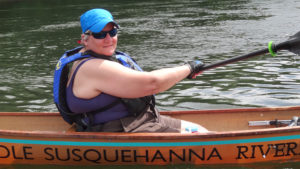
Outdoor opportunities are plentiful in the Valley, and the lifeblood flowing through it all is the Susquehanna River.
Which would make Carol Parenzan the region’s top hematologist. Since January of 2016, she has been the Susquehanna Riverkeeper. She is the one who speaks for the river, for the fish and for all of us who depend on the river in some fashion or another.
“In general, our greatest threat to the watershed is awareness. Much of my work focuses on education and helping individuals and communities find that connection to the river,” Parenzan said. “The primary goal of all Waterkeeper programs is to hold polluters accountable as we work to bring swimmable, drinkable, fishable water to everyone.”
For the past 18 months, she has been heavily involved in everything Susquehanna. She recently attended a DEP watershed implementation plan meeting in Harrisburg, complete with 30 workstations throughout the event that focused on challenges within the Chesapeake Bay watershed.
“It went over phosphorus concerns, especially those among more concentrated farming lands in the lower Susquehanna Valley,” she said. “We also discussed the issue of abandoned mine discharge, looked at sedimentation and other areas of concern.”
Among the biggest concerns are one of the smallest creatures that are increasingly missing from our section of the river.
“One of the greatest threats to the watershed is the loss of freshwater mussels due to a variety of factors. Mussels function as the kidneys of the river. They filter vast quantities of water daily, removing contaminants and sedimentation,” Parenzan said. “The life cycle of the mussel is directly dependent on the migration of the American eel since the mussel larva hitchhikes upriver on the migrating eel to find its way to our part of the watershed. The eels find it difficult to get past the dams. Therefore, mussels — especially younger ones — are not readily present in this part of the river.”
Fortunately, she admitted that the Susquehanna is bouncing back in some aspects.
“We’re improving in areas such as phosphorus, nitrogen and sedimentation issues,” she said. “But there is still a ways to go. Abandoned mine runoff is a concern, as are pharmaceuticals in the river. We are working with various groups to see how to best address that.”
Parenzan is not afraid to think outside of the box when it comes to creative ways to help the river. She has started training her 20-month-old Nova Scotia Duck Tolling Retriever — aptly named Susquehanna — to be one of just a few dogs nationally trained to detect sewage leaks within the watershed.
One of 320 licensed Waterkeepers representing 35 countries over six continents, Parenzan just last week attended a conference with her peers in Utah to talk shop and creatively look at better ways to protect the Susquehanna River.
“Two direct results of the conference for me are the expansion of our water quality monitoring program with a new partner and the plans to become certified as a stormwater inspector to further protect the river,” she said.
She admitted that everyone can play a part in cleaning up and protecting the Susquehanna.
“Take little steps — just a little bit of action can create a result much larger. Start by helping keep the trash out of the river, including the creeks and streams that lead into the river,” she said. “Plastics in a watershed can cause a big issue, whether they are plastic grocery bags or plastic bottles or even the wrapping off fast food. As the sun hits it, it breaks down, and chemicals leech off into the water.”
Another area to help is through proper medication disposal.
“There are drop-off places where people can take unused pharmaceuticals, but I think we can do a better job of making it easier to dispose of those medications properly,” she said. “I need to engage the communities and see if we can get more doctors and nurses be involved in taking back medication and making it easier to dispose of correctly.”
Another way to get involved is through a unique program Parenzan has planned for July 22 called the Sunrise Sunset Susquehanna Paddle and Play.
“There will be three components. In the morning, people can paddle 11 miles from Jersey Shore to the Susquehanna State Park in Williamsport,” she said. “In the afternoon, there will be all sorts of activities at the park, including live music, storytelling, environmental education, wellness activities and, of course, food.
“In the evening, I’ve chartered the Hiawatha and there will be rides with the Audubon Society watching for birds and enjoying the river.”
Cost for the 11-mile morning paddle is $45 per person if registered by June 30 or $55 for those who preregister between July 1-19. Those who don’t have a kayak or other watercraft can rent one through Canoe Susquehanna. Cost for the Hiawatha cruise is $25. Purchase tickets or gather more information about the event at middlesusquehannariverkeeper.org.


